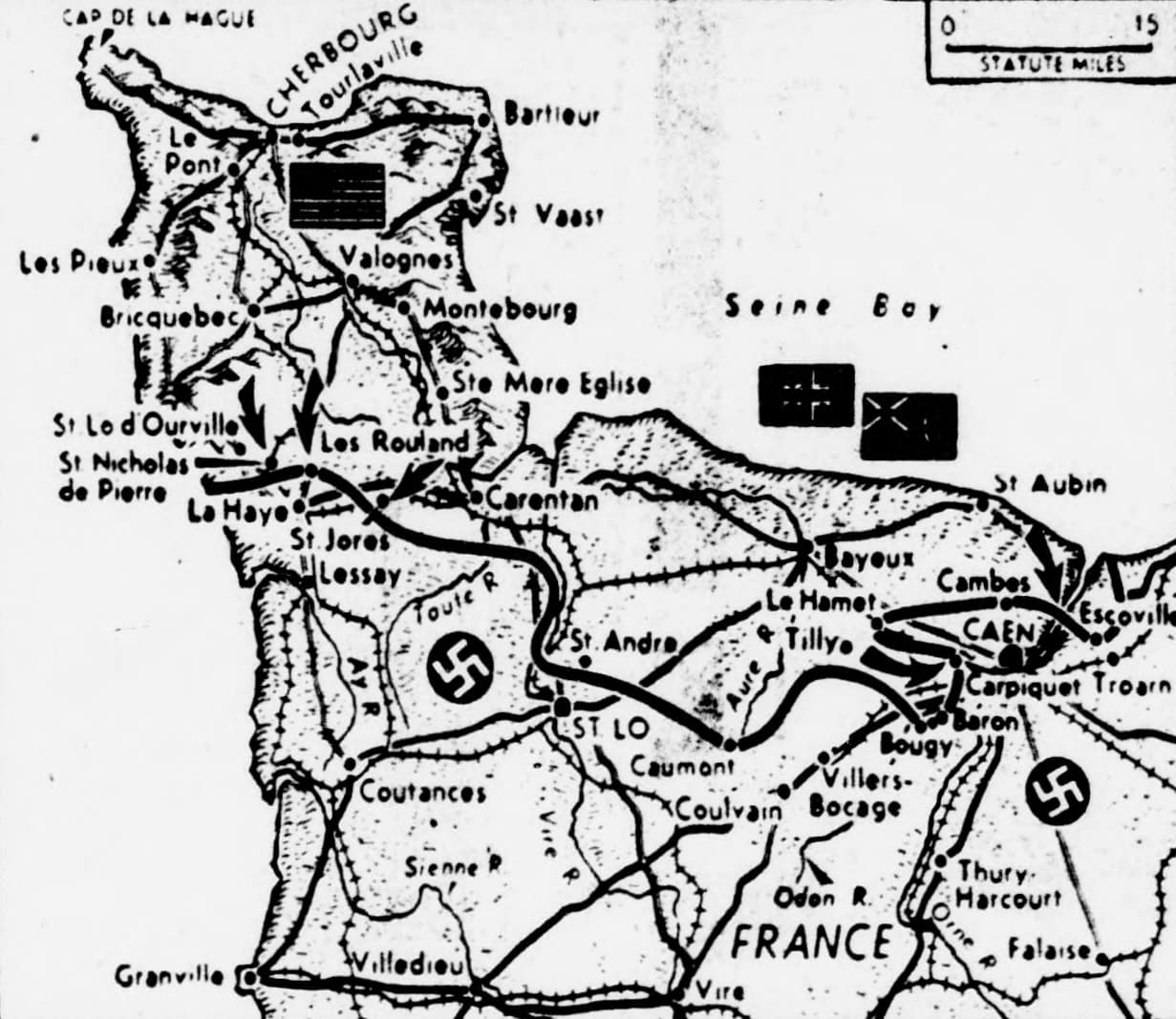The Free Lance-Star (July 3, 1944)
AMERICANS LAUNCH ATTACK SOUTHWARD FROM CHERBOURG
Heavy artillery barrage starts drive at dawn
Nazis repulsed in fighting at Caen
SHAEF, England (AP) –
American G.I.s turning from the mop-up of Cherbourg burst southward on the peninsula in a dawn attack today after a heavy artillery barrage, fighting on mud-bogged French battlefields reminiscent of World War I.The assault jumped off near the west coast of the peninsula, from the line flung across it just two weeks ago that sealed off the upper half of the land neck.
A front dispatch said the drive pushed from the area below Barneville-sur-Mer on the coast east of Saint-Sauveur-le-Vicomte. The doughboy line dips below and between those towns to Saint-Lô-d’Ourville.
The assault opened after local advances which Supreme Headquarters said had won favorable “jump-off” positions.
U.S. infantrymen were supported by heavy artillery including some of the most powerful guns used in the French campaign, but rain and cloudy skies hampered Allied aerial aid.
The new offensive came after Lt. Gen. Omar N. Bradley, commanding the U.S. 1st Army in Normandy, hailed the Cherbourg victory as “an indication to the enemy as to what he can expect from now on to the end.”
SHAEF, England (AP) –
Troops of the U.S. 1st Army have advanced in widely-separated local attacks and seized favorable “jump-off positions south of Saint-Lô-d’Ourville and west of Caumont, while British artillery has smashed a 25th German counterthrust at the Odon River bridgehead in the bitterly-fought Caen sector.
The activity of Gen. Omar N. Bradley’s forces in the southern part of the Cherbourg Peninsula was the first since the drive on the port of Cherbourg was launched two weeks ago.
German salient thrusting into U.S. lines near Saint-Lô-d’Ourville were wiped out, and the Americans advanced short distances toward La Haye-du-Puits, rail and highway junction, seizing high ground which was described by Supreme Headquarters as probably “good jump-off spots” for an eventual attack toward the south.
West of Caumont, Bradley lashed out with similar local attacks with the same object in mind. This sector is roughly 17 air miles southwest of the British Odon River bridgehead.
Prepare new attack
Activity dwindled in the Caen sector, where Field Marshal Gen. Erwin Rommel appeared to be regrouping his seven panzer and four infantry divisions which had taken a terrific mauling in three days of furious but futile attacks against the British. Indications were that Rommel was readying an all-out counterattack against the British. “We are ready,” said one British officer.
Clouds so dense that the airmen called them “ten-tenths” cloaked the entire bridgehead in Normandy. The weather was getting to be known as the worst for June and July in the past 40 years. Allied air forces were able to fly only about 400 sorties over the battle area yesterday, but they managed to shoot down 22 enemy aircraft against a loss of three of their own, Communiqué No. 55 disclosed.
Take more prisoners
In the Cherbourg area, U.S. 1st Army units were in the process of reorganization for “offensive action” after the mopping up of the last German resistance in Cap de la Hague over the weekend. Between 2,000 and 3,000 more prisoners were taken in the process. An Associated Press dispatch from Cherbourg said the American bag of prisoners had reached 40,000, which would indicate the total since D-Day had reached more than 55,000.
Gen. Sir Bernard L. Montgomery’s superiority in artillery in the crew fighting smashed every attempt of the Germans to infiltrate into the Odon River bridgehead. The Nazis made 25 attacks in 72 hours, the latest shortly before dawn yesterday. A barrage from British heavy guns broke it up before it even reached infantry positions.
British patrols expanding the Caen salient found Brettevillette, two miles south of Tessel-Bretteville, unoccupied by the Germans, although heavily mined and boobytrapped.
Continual heavy rain greatly handicapped the Allies. Clouds hung tree-high over many acres of the battlefront.
Last night, the London radio in a broadcast recorded by CBS declared “gigantic Allied landing operations” took place Sunday on the coast behind the British forces while armored vehicles, tanks, troops and ammunition also landed on the southeastern side of the Cherbourg Peninsula.
Enemy confused
Associated Press correspondent Roger Greene reported from the field last night that the enemy was “lying silent and apparently bewildered as to what to do next against the explosive violence of Montgomery’s strongbox defenses.”
The job of making the Cherbourg Harbor ready to receive great quantities of supplies and thousands of men went forward rapidly. German demolitions were termed “a clever job,” but no worse than expected.
One officer said Rommel’s attempt to erase the British salient at Caen was a major action which had cost the enemy “elaborate losses and a terrific mauling.”
A senior British staff officer said the situation on the whole Normandy front was “extremely satisfactory.” He remarked that German tactics thus far “are unlikely to serve as a textbook for repelling invasions.” Rommel’s tactical reserves had failed to hold the British and he had been forced to bring up strategic reserves from the rear – which he likewise wasted away in costly but fruitless attacks on the British.
